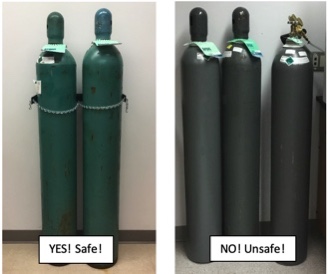EHS’ Quick Guide to Compressed Gas Cylinder Safety
April 12, 2021 Angelica Nadali
UMB’s Department of Environmental Health and Safety (EHS) has prepared a quick “how-to” guide for safely handling and storing compressed gas cylinders around campus.
Compressed gas cylinders are highly pressurized containers of hazardous gas that are used in research laboratory operations. The Occupational Safety and Health Administration sets standards for their use, and you can find additional information in Section 1.6 of the University of Maryland, Baltimore’s (UMB) Chemical Hygiene Plan. Their contents may be flammable, corrosive, or even cryogenic. Commonly used compressed gases that you may see around campus include hydrogen, oxygen, carbon monoxide, nitrogen, and carbon dioxide.
When working with compressed gas cylinders, lab members must be adequately trained on the proper use, handling, storage, and disposal. Although the actual container may look harmless, keep in mind that compressed gas cylinders pose mechanical, physical, inhalation, and/or other health hazards if used carelessly. They may displace oxygen in your environment when not properly monitored, are harmful to be inhaled, can cause severe skin burns or irritation, can break your bones, and even cause fatal crushing injuries. Your vendor will securely deliver and collect the cylinder, and it is your responsibility to secure the cylinder until it is collected by the vendor. If you need a bracket, contact Operations and Maintenance at 410-706-7570 for a quote.
As we continue ramping up COVID-19 recovery efforts in our research labs, UMB's Department of Environmental Health and Safety (EHS) strongly recommends also implementing these top 10 best practices when working with compressed gases to help protect the health and the safety of UMB staff, faculty, students, and visitors.
10 Things You Need to Know Before Working with Compressed Gases
1. Secure it! Secure empty, full, or partially filled cylinders to a sturdy upright fixture (i.e. bench, wall) with a chain, strap, or floor clamp.
2. Cap it! Valve protection caps must be securely in place whenever the compressed gas cylinder is not attached to a regulator, even if empty.
3. Big and small! All cylinders regardless of size must be secured. Appropriate mounting devices may be ordered online.
4. Segregate! Compressed gas cylinders connected to regulators must be secured with a separate mounting device, chain, or strap from unconnected cylinders.
5. Move it! Only transport cylinders using an appropriate, safe method such as a cylinder cart. Never roll a cylinder, or carry or transport a cylinder in a horizontal position.
6. Don’t break it! Contact your vendor if the cap is jammed. Never attempt to use a wrench or any other device to pry off a cap.
7. Get help! Contact Operations and Maintenance at 410-706-7570 for a quote for the bracket and installation. Do not install yourself.
8. Replace and return! Contact the vendor for collection of compressed gas cylinders, especially when vacating a lab.
9. Be safe! Use appropriate personal protective equipment, such as lab coats, gloves, face shields, and safety glasses, when working with compressed gases.
10. When in doubt, reach out! Contact EHS at 410-706-7055 for safety concerns or questions.